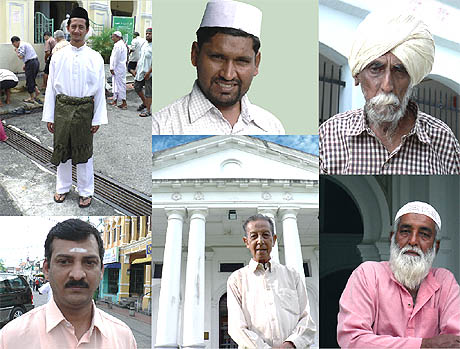|
World
Religion Walk, Penang
Religious
Co-Existence

The
Street of Harmony
JALAN MASJID KAPITAN KELING (formerly Pitt Street)
There
is a special place in Penang, dubbed the 'Street of Harmony'.
Here, houses of worship representing various world religions are
lined up along an axis. The place illustrates a history of peaceful
religious co-existence and cultural exchange among the followers
of the great faiths of Islam, Buddhism,Hinduism, Christianity,
as well as the Chinese religion, which combines Confucianism,Taoism
and Buddhism.
Cultural
Encounter
Penang
society was shaped by waves of migration. Traders, workers and
adventurers from the Malay kingdoms, Indonesia, Thailand, Myanmar,
China, India, Sri Lanka, Europe, the Middle East and Japan came
to settle. With a history of more than 200 years of ethnic and
religious co-existence, Penang demonstrates exchanges between
these communities that go beyond mere tolerance of diversity.

 Freedom
of Worship Freedom
of Worship
The
policy of religious freedom which characterised British rule in
Malaya was first formulated in Penang.
Located
midway between India and China, the port of Penang was established
by Captain Francis Light in 1786 as a trading post for the East
India Company. As the new settlement attracted 10,000 settlers
of all creeds and nations, Light proposed that 'each race has
a right to preserve its civil and religious peculiarities.'
 . .
.
Today, Islam is Malaysia's official religion but freedom of worship
is guaranteed by the federal constitution.
A
Shared Heritage
Penang
has preserved the rich legacies of its Islamic, Buddhist, Confucian,
Taoist, Hindu, Sikh and Christian communities. These legacies
can be seen in Penang's culture, architecture and contemporary
religious practices. The bygone diaspora communities of Armenians
and Jews are remembered in historic sites and street names.
 Today,
the city of George Town, capital of Penang, is blessed with more
than 100 spiritual sites built by consecutive waves of migrants
and sojourners. Although the port settlement has developed into
a modern city, George Town remains the spiritual heartland for
diverse communities whose ancestors settled in Penang before moving
on to other parts of Malaysia, Southeast Asia and the world. Today,
the city of George Town, capital of Penang, is blessed with more
than 100 spiritual sites built by consecutive waves of migrants
and sojourners. Although the port settlement has developed into
a modern city, George Town remains the spiritual heartland for
diverse communities whose ancestors settled in Penang before moving
on to other parts of Malaysia, Southeast Asia and the world.
Popham
Map, 1798
Early
George Town consists of a grid of streets bounded by Light Street,
Beach Street, Chulia Street and Pitt Street. During the term of
Lieutenant-Governor Sir George Leith (1801-1803), some of the
religious institutions along Pitt Street were issued land titles.
The
Penang Global Ethic Project
Penang's
'Street of Harmony' is a place where people of all nationalities,
backgrounds and ages can learn about the traditions of peaceful
co-existence among communities of different cultures and faiths.
The Penang Global Ethic Project is a long-term project to showcase
this internationally unique site.
Launched
in February 2006 with a series of lectures, forums, tours and
exhibitions on 'World Religions – Universal Peace –
Global Ethic', the Penang Global Ethic Project aims to promote
a wider understanding of the ethical principles held in common
by the major world religions.
 Virtual
tour of the "World Religion Walk, Penang" Virtual
tour of the "World Religion Walk, Penang"
Click
here to begin your walk.
Produced
by Lestari Heritage Network
© All rights reserved.
Photos by Goh Hun Meng and
Tan Yeow Wooi ©
All rights reserved.
. |

